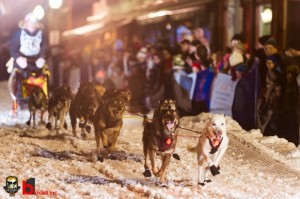
Leave it to students from Michigan Technological University to up the ante on an already exciting race. Two teams of students are lending their talents to the CopperDog 150 Sled Dog Race in the Keweenaw this weekend.
One team will focus on real-time statistics; the other will help provide near-live video streaming via YouTube.
It’s all part of a team dynamics/problem solving course in the School of Business and Economics, taught by Michele Loughead.
“The goal is for students to learn how to create and operate in highly effective teams,” Loughead, an instructor, says. “I teach the tools, but more importantly, we focus on the relationship between each team member,”
It seems to be working. Ben Christensen, a third-year computer network and system administration major from Howell, is spearheading the number crunchers.
“We’ve set up a system that takes the raw data and automatically does all of the calculations and posts it without user intervention,” he says. “All that a person needs to do is put in the raw check-in times from the radio operators.”
He’s especially excited about a new feature: forecasting arrival times at checkpoints.
“We’ll be keeping live stats on the mushers’ average speed and lead times, and posting them all on the leader board,” he says, showing his team’s handiwork on his laptop.
Using last year’s results, they’ve created an interface that will show all the mushers and their times between checkpoints. Rolling over the display reveals their locations.
“And we’ve only been at it for four weeks,” he says. “We looked at other races, like the UP 200 in Marquette, and other sports. Horse racing has some similarities.”
The difference here, he says, is the staggered start of the teams, complicating matters a bit.
“We also called and emailed some of the mushers to see what they would like us to include.”
Radio operators around the course will report the teams’ progress through the checkpoints to a central recording location in Calumet. There, Christensen and his team will crunch the numbers and post them on a high-speed Internet-based spreadsheet for the world to see.
“We had to answer some questions to proceed: what stats to collect, what formulas and calculations to use, how to present it and how to design for the user experience,” Christensen says.
And that includes a smart-device version, half the size of the original, for phones and other smaller screens.
Is it live? Almost.
Nikoli Wiens is leading the team capturing the race on video. The complications are many; but the payoff will be great, the accounting student says.
“We will have access to the dedicated high-speed Internet connection, so that will be huge,” the accounting major from Duluth says. “We’ll be doing video around the starting point, but we want to get out to the checkpoints, too.”
Therein lies the bigger problem: how to get the high-definition video shot out in the woods and brought back to Calumet for uploading in an efficient manner.
“We plan on editing while we’re getting driven back,” he says. “We also need to figure out what to put in, what will be relevant to people. We have to be as prepared as possible beforehand because we know it will be crazy that weekend.”
Teamwork will help, he says. They’ve known each other for a while and work well together.
Good thing.
“There’s so much stuff that needs to be done, he says, “and this is real-world experience, especially under these time constraints.”
Their ultimate goal, driven by Todd Brassard, executive race director, is to “recreate the atmosphere of the event,” Wiens says.
“We want to talk to spectators, too, as well as the mushers,” he says. “We know getting all this online will be a challenge, but it will also be a lot of fun.
And he’s looking down the trail.
“I won’t be able to see the race as much this year, but in the future, after we have a system down and students build it better, smarter and faster when I’m not here, I can come back some day and enjoy the race.”
Brassard is more than happy for the help.
“It makes a lot of sense for us to leverage the brains and work ethics of Michigan Tech students to develop and grow the event,” he says. “With the help of the two teams from the Business School, we are bringing the information we output to the world to a whole new level, with real-time standings and human interest video updates during the event.”
“With only four weeks from concept to execution, if we succeed, it’s going to be amazing,” he adds.
This story was originally published by Dennis Walkainen for Michigan Tech News.